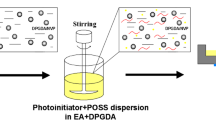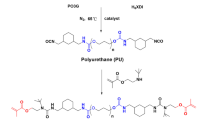Abstract
The adipic acid glycidyl methacrylate (AA-GMA) containing double bond of carbon and hydroxyl as an ultraviolet-polyurethane dual-curing oligomer was prepared as a precursor to resin for three-dimensional (3D) printing. A dual-curing resin for 3D printing was formulated from the AA-GMA, PHDI (hexamethylene diisocyanate-based polyisocyanates, mainly trimer) and other reagents. The dual-curing oligomer AA-GMA was synthesized by the epoxide ring-opening reaction with dicarboxylic acid and the molecular structure of which was characterized by FTIR and 1H NMR analyses. AA-GMA has the double bond which could be cured via ultraviolet irradiation in the 3D printing process, and the hydroxyl could be cured by PU curing agent PHDI at the thermal post-curing process. The PHDI was not only employed as a diluent in the 3D printing process, but also acted as a reactant for post-curing. Compared to the traditional single-curing resin, this dual-curing resin could provide products with increased crosslinking density, flexibility and reduced volumetric shrinkage rate. The tensile strength of dual-curing sample was improved to 64 MPa after adding 20 wt% PHDI, which showed 18% boost compared to the sample without the PHDI. For the sample with a content of 30 wt% PHDI, the glass transition temperature (Tg) was about 121 °C, presenting 35 °C higher than that of the blank sample.













Similar content being viewed by others
References
Farahani RD, Dube M, Therriault D (2016) Three-dimensional printing of multifunctional nanocomposites: manufacturing techniques and applications. Adv Mater 28(28):5794–5821. https://doi.org/10.1002/adma.201506215
Feng X, Yang Z, Rostom SSH, Dadmun M, Wang S, Wang Q, Xie Y (2018) Reinforcing 3D printed acrylonitrile butadiene styrene by impregnation of methacrylate resin and cellulose nanocrystal mixture: structural effects and homogeneous properties. Mater Des 138:62–70. https://doi.org/10.1016/j.matdes.2017.10.050
Utela B, Storti D, Anderson R, Ganter M (2008) A review of process development steps for new material systems in three dimensional printing (3DP). J Manuf Process 10(2):96–104. https://doi.org/10.1016/j.jmapro.2009.03.002
Yue J, Zhao P, Gerasimov JY, van de Lagemaat M, Grotenhuis A, Rustema-Abbing M, van der Mei HC, Busscher HJ, Herrmann A, Ren Y (2015) 3D-printable antimicrobial composite resins. Adv Funct Mater 25(43):6756–6767. https://doi.org/10.1002/adfm.201502384
Kroll E, Artzi D (2011) Enhancing aerospace engineering students’ learning with 3D printing wind-tunnel models. Rapid Prototyp J 17(5):393–402
Espalin D, Muse DW, Macdonald E, Wicker RB (2014) 3D printing multifunctionality: structures with electronics. Int J Adv Manuf Technol 72(5–8):963–978
Berman B (2012) 3-D printing: the new industrial revolution. Bus Horiz 55(2):155–162. https://doi.org/10.1016/j.bushor.2011.11.003
Ahn BU, Lee SK, Lee SK, Jeong HM, Kim BK (2007) High performance UV curable polyurethane dispersions by incorporating multifunctional extender. Prog Org Coat 60(1):17–23. https://doi.org/10.1016/j.porgcoat.2007.06.001
Decker C (2010) Kinetic study and new applications of UV radiation curing. Macromol Rapid Commun 23(18):1067–1093
Pappas SP (2013) Radiation curing: science and technology. Springer, Berlin
Roffey CG (1997) Photogeneration of reactive species for UV curing. Wiley, Hoboken
Allen NS (1989) Photopolymerisation and photoimaging science and technology. Springer, Berlin
Allen NS (1996) Photoinitiators for UV and visible curing of coatings: mechanisms and properties. J Photochem Photobiol A 100(1–3):101–107
Kuang X, Zhao Z, Chen K, Fang D, Kang G, Qi HJ (2018) High-speed 3D printing of high-performance thermosetting polymers via two-stage curing. Macromol Rapid Commun 39(7):e1700809. https://doi.org/10.1002/marc.201700809
Invernizzi M, Natale G, Levi M, Turri S, Griffini G (2016) UV-assisted 3D printing of glass and carbon fiber-reinforced dual-cure polymer composites. Materials (Basel) 9:583–594. https://doi.org/10.3390/ma9070583
Griffini G, Invernizzi M, Levi M, Natale G, Postiglione G, Turri S (2016) 3D-printable CFR polymer composites with dual-cure sequential IPNs. Polymer 91:174–179. https://doi.org/10.1016/j.polymer.2016.03.048
Chen K, Kuang X, Li V, Kang G, Qi HJ (2018) Fabrication of tough epoxy with shape memory effects by UV-assisted direct-ink write printing. Soft Matter 14(10):1879–1886. https://doi.org/10.1039/c7sm02362f
Yang CH, Liu FJ, Liu YP, Liao WT (2006) Hybrids of colloidal silica and waterborne polyurethane. J Colloid Interface Sci 302(1):123–132. https://doi.org/10.1016/j.jcis.2006.06.001
Ahn BU, Lee SK, Lee SK, Park JH, Kim BK (2008) UV curable polyurethane dispersions from polyisocyanate and organosilane. Prog Org Coat 62(3):258–264. https://doi.org/10.1016/j.porgcoat.2008.01.001
Unal S, Oguz C, Yilgor E, Gallivan M, Long TE, Yilgor I (2005) Understanding the structure development in hyperbranched polymers prepared by oligomeric A2 + B3 approach: comparison of experimental results and simulations. Polymer 46(13):4533–4543
Zhu SW, Shi WF (2002) Synthesis and photopolymerization of hyperbranched polyurethane acrylates applied to UV curable flame retardant coatings. Polym Int 51(3):223–227
Lin D, Liu B, Xu L, Budzinski KL, Shou C (2011) Synthesis of hyperbranched polyester-amides and their application as crosslinkers for polyurethane curing systems. J Appl Polym Sci 121(2):957–963. https://doi.org/10.1002/app.33678
Xiang B, He HY, Zhu RQ, Liao J, Chen S (2011) Photo-aging of polyurethane coating based on TDI-TMP and N3390. Adv Mater Res 189–193:1100–1104. https://doi.org/10.4028/www.scientific.net/AMR.189-193.1100
Vitale A, Cabral JT (2016) Frontal conversion and uniformity in 3D printing by photopolymerisation. Materials (Basel) 9(9):760. https://doi.org/10.3390/ma9090760
Bukowska A, Bukowski W, Noworól J (2005) Catalytic activity of salenCo(III)OAc complex in the reaction of addition of carboxylic acids to terminal epoxides. J Mol Catal A Chem 225(1):7–10. https://doi.org/10.1016/j.molcata.2004.08.016
Biryan F, Demirelli K (2017) Copolymerization of benzyl methacrylate and a methacrylate bearing benzophenoxy and hydroxyl side groups: monomer reactivity ratios, thermal studies and dielectric measurements. Fibers Polymers 18(9):1629–1637. https://doi.org/10.1007/s12221-017-6707-9
Mu Q, Wang L, Dunn CK, Kuang X, Duan F, Zhang Z, Qi HJ, Wang T (2017) Digital light processing 3D printing of conductive complex structures. Addit Manuf 18:74–83. https://doi.org/10.1016/j.addma.2017.08.011
Steyrer B, Busetti B, Harakály G, Liska R, Stampfl J (2018) Hot Lithography versus room temperature DLP 3D-printing of a dimethacrylate. Addit Manuf 21:209–214. https://doi.org/10.1016/j.addma.2018.03.013
Zeng Y, Yan Y, Yan H, Liu C, Li P, Dong P, Zhao Y, Chen J (2018) 3D printing of hydroxyapatite scaffolds with good mechanical and biocompatible properties by digital light processing. J Mater Sci 53(9):6291–6301. https://doi.org/10.1007/s10853-018-1992-2
Hegde M, Meenakshisundaram V, Chartrain N, Sekhar S, Tafti D, Williams CB, Long TE (2017) 3D printing all-aromatic polyimides using mask-projection stereolithography: processing the nonprocessable. Adv Mater. https://doi.org/10.1002/adma.201701240
Harkal UD, Muehlberg AJ, Webster DC (2012) UV curable glycidyl carbamate based resins. Prog Org Coat 73(1):19–25. https://doi.org/10.1016/j.porgcoat.2011.08.014
Higginbottom HP, Bowers GR, Ferrell PE, Hill LW (1999) Cure of secondary carbamate groups by melamine-formaldehyde resins. J Coat Technol 71(894):49–60
Zhu J, Yuan L, Guan Q, Liang G, Gu A (2017) A novel strategy of fabricating high performance UV-resistant aramid fibers with simultaneously improved surface activity, thermal and mechanical properties through building polydopamine and graphene oxide bi-layer coatings. Chem Eng J 310:134–147. https://doi.org/10.1016/j.cej.2016.10.099
Monteiro SN, Calado V, Margem FM, Rodriguez RJS (2012) Thermogravimetric stability behavior of less common lignocellulosic fibers—a review. J Mater Res Technol 1(3):189–199
Yan X, Zhang M, Qi S, Tian G, Niu H, Wu D (2017) A high-performance aromatic co-polyimide fiber: structure and property relationship during gradient thermal annealing. J Mater Sci 53(3):2193–2207. https://doi.org/10.1007/s10853-017-1552-1
Acknowledgements
The work described in this paper was supported by the State’s Key Project of Research and Development Plan (Grant No. 2016YFB1100900) and the Key Research Program of the Chinese Academy of Sciences (Grant No. ZDRW-CN-2016-1). We also thank Nidhin Divakaran and Dhamodharan for useful suggestions on English grammar.
Author information
Authors and Affiliations
Corresponding authors
Rights and permissions
About this article
Cite this article
Zhou, ZX., Li, YW., Zheng, YQ. et al. Synthesis and characterization of a dual-curing resin for three-dimensional printing. J Mater Sci 54, 5865–5876 (2019). https://doi.org/10.1007/s10853-018-3117-3
Received:
Accepted:
Published:
Issue Date:
DOI: https://doi.org/10.1007/s10853-018-3117-3




